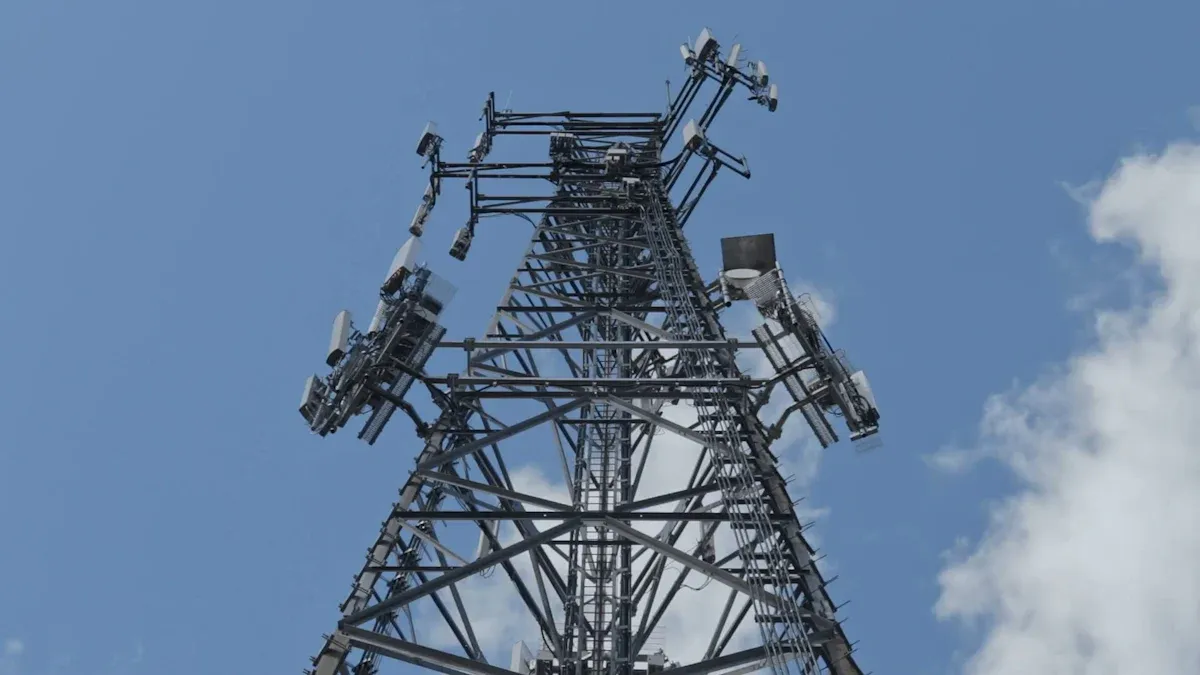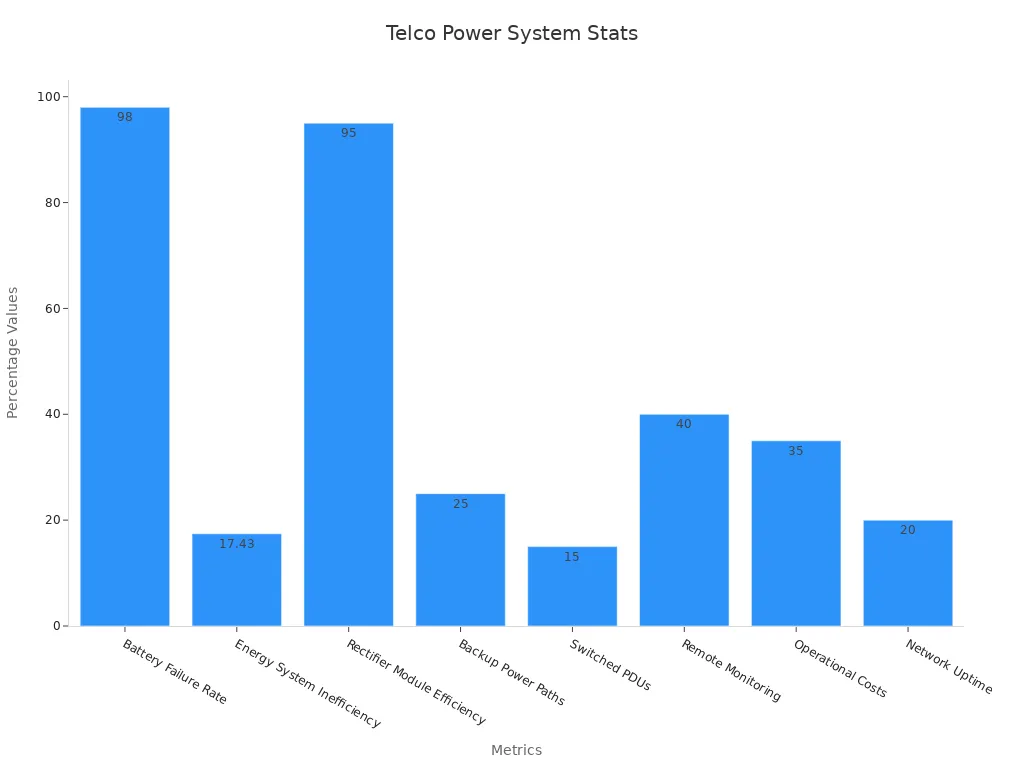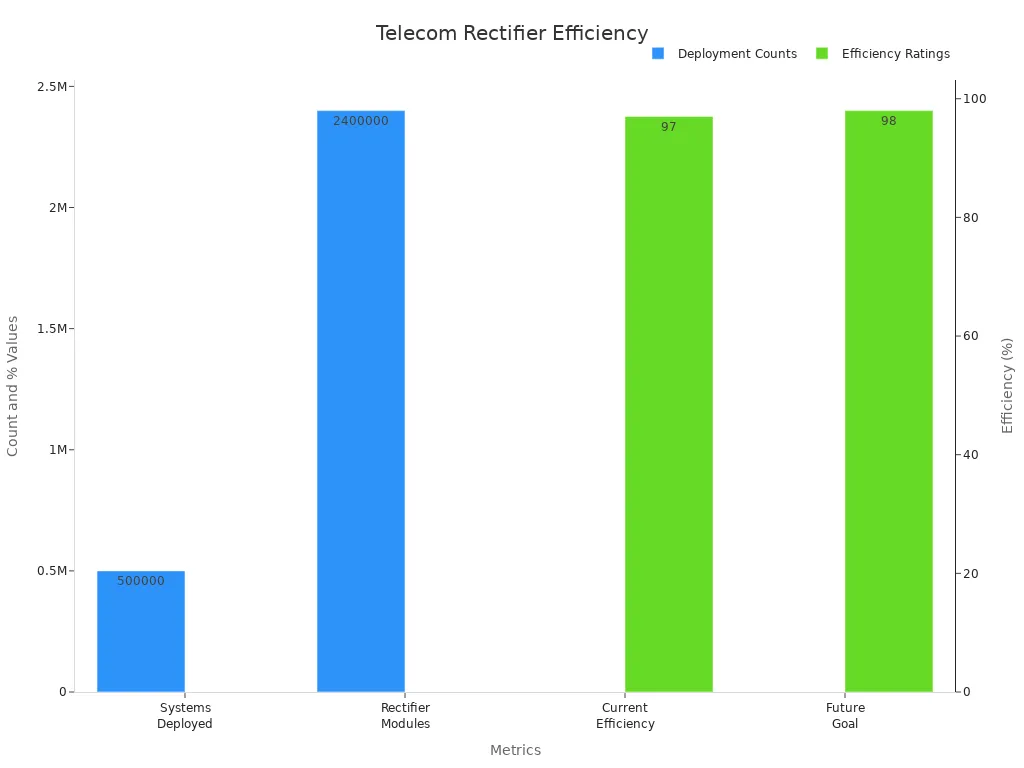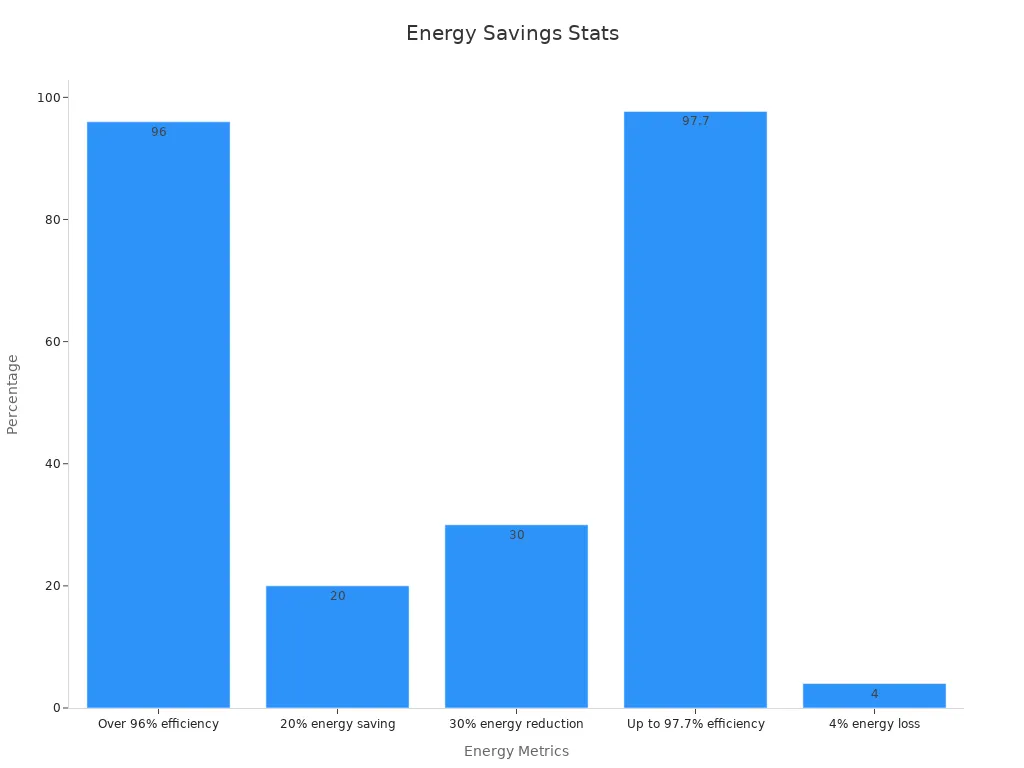Emerging Trends in Modular 48V DC Telecom Rectifiers for Outdoor Base Stations

Telecom infrastructure faces rapid transformation as market trends push for greater efficiency, reliability, and sustainability in outdoor base station power systems. Modular rectifier technology now dominates these advances, with rectifier module efficiency exceeding 95% and a 98% drop in battery failure rates since 2018. Operators see a 20% improvement in network uptime and a 35% reduction in operational costs, driven by innovations such as AI-driven maintenance and renewable integration. The modular 48V DC telecom rectifier for outdoor base stations sets a new forecast for robust, scalable energy systems.
Metric/Aspect | Evidence/Statistic | Impact/Improvement Description |
|---|---|---|
Rectifier Module Efficiency | Exceeds 95% efficiency | Minimizes energy losses, reduces operational costs |
Battery Failure Rate | 98% reduction from 2018 to 2024 | Significantly improved reliability |
Network Uptime | 20% improvement | Enhanced service reliability and availability |
Operational Costs | 35% reduction | Cost savings through hybrid power deployment |

Key Takeaways
Modular 48V DC telecom rectifiers offer high energy efficiency above 95%, reducing power loss and cutting operational costs significantly.
Plug-and-play and modular designs enable easy scaling, quick maintenance, and reliable power delivery for outdoor base stations, even in harsh environments.
AI and IoT integration improve rectifier performance by enabling real-time monitoring, predictive maintenance, and energy optimization, lowering downtime and expenses.
Renewable energy integration with modular rectifiers supports sustainability goals by reducing carbon emissions and enhancing network resilience.
The telecom rectifier market is growing rapidly, driven by 5G expansion, demand for energy savings, and the need for scalable, eco-friendly power solutions.
Key Drivers
Data Growth and 5G
The dc power systems market faces unprecedented pressure as mobile data traffic surges and 5g networks expand. Research shows that the number of connected devices and the rollout of 5g networks have doubled telecom network power consumption in regions like China, rising from over 50 billion kWh to more than 100 billion kWh. Urban areas experience up to 80% traffic growth, with dense urban sites seeing traffic demands up to 1000 times higher than rural locations. The adoption of Massive MIMO technology in 5g network densification increases site energy consumption from 5-7 kW in 4G to over 20 kW in 5G. As a result, the dc power systems market must adapt with high-efficiency rectifier solutions and robust 48v systems to support this growth. Operators now prioritize energy efficiency and advanced rectifier designs to manage higher loads and ensure reliable connectivity.
Outdoor Demands
Outdoor base stations operate in challenging environments, requiring rectifier systems that deliver consistent performance despite temperature extremes, humidity, and dust. The dc power systems market responds with modular 48v rectifier cabinets that feature plug-and-play designs and advanced thermal management. These solutions support the 48v system standard, which simplifies maintenance and enables rapid upgrades. As 5g networks proliferate, outdoor sites must handle increased power density and fluctuating loads. The dc power systems market now emphasizes reliability and scalability, ensuring that telecom infrastructure can maintain connectivity even in remote or harsh locations.
Sustainability Push
Sustainability drives innovation in the dc power systems market. Environmental directives, such as the EU Green Deal, push operators to adopt energy efficiency measures and integrate renewable energy sources. Modern rectifier systems now support hybrid power configurations, combining grid, solar, and battery storage to reduce carbon emissions. The 48v system architecture enables seamless integration of renewable energy, helping operators meet regulatory requirements and corporate sustainability goals. As the dc power systems market evolves, energy efficiency and renewable energy adoption become central to future-ready telecom infrastructure.
Tech Innovations
Modularity and Hot-Swap
Telecom operators increasingly rely on modular dc systems to address the dynamic power needs of outdoor base stations. Modular rectifier architectures allow seamless addition or removal of modules, supporting rapid scaling as network demands shift. This flexibility reduces the need for full system replacements, saving both time and resources. Modular designs, such as those from Eaton Corporation, have enabled the deployment of over 500,000 systems and 2.4 million rectifier modules globally. These systems approach 97% efficiency, with future targets nearing 98%, setting new standards for energy efficiency and high power density.
Metric | Value |
|---|---|
Total systems deployed | 500,000 |
Total rectifier modules | 2,400,000 |
Efficiency of rectifier modules | Approaching 97% |
Future efficiency goal | Approaching 98% |
Eltek Valere’s Flatpack2 HE Rectifier Module exemplifies this trend, achieving 96% efficiency and supporting scalable power outputs up to 100 kW. Operators benefit from advanced digital control and hybrid converter topologies, which reduce power losses and component count. Hot-swap capability ensures that maintenance or upgrades do not disrupt network operations, a critical feature for 48v system deployments in remote or high-traffic locations.

AI and IoT Integration
Artificial intelligence and IoT have transformed rectifier management and maintenance. AI-driven predictive maintenance reduces downtime by up to 50% and cuts maintenance costs by as much as 30%. Real-time monitoring through IoT sensors enables smart thermal management systems, using advanced sensors like Fiber Bragg Grating for battery temperature and infrared sensors for motor temperature. These technologies prevent overheating and extend equipment lifespan, directly impacting network reliability.
Operators deploying ESTEL’s modular rectifiers with AI and IoT capabilities have reported 20% energy savings. AI-powered dynamic power optimization adjusts power consumption based on network demand, further improving energy efficiency. Modular dc systems with integrated monitoring allow easy scaling and maintenance, minimizing downtime and maximizing operational flexibility. AI and machine learning also enhance fault detection, diagnostics, and power distribution, ensuring optimal performance for the 48v system.
Renewable Energy
The integration of renewable energy into telecom rectifier systems has accelerated, driven by sustainability goals and regulatory pressures. Operators replacing diesel generators with solar or wind systems at telecom sites have achieved a 20% annual reduction in power consumption. Hybrid renewable energy systems, often optimized with simulation tools, combine solar PV, wind, and even biomass to improve off-grid network reliability.
Solar-powered smart grids with integrated rectifiers have demonstrated up to 20% improvements in energy transfer efficiency. Smart rectifiers with adaptive controls can achieve up to 30% energy savings by optimizing power conversion. The adoption of microinverters and dc dc converters further enhances renewable energy system performance, supporting decentralized and resilient telecom infrastructure. The global industrial rectifiers market, growing at a 5.6% CAGR, reflects this shift toward renewable energy and energy efficiency. Government incentives and advances in silicon carbide and gallium nitride semiconductors continue to drive these innovations.
Battery Management
Advanced battery management systems play a vital role in modern rectifier cabinets. ESTEL’s modular converter systems enable easy scaling and maintenance, while fault isolation limits the impact of failures to specific modules. This approach improves reliability and reduces the risk of widespread outages. Real-time diagnostics and monitoring of voltage, current, and temperature extend battery lifespan and minimize downtime.
Feature | ESTEL Systems | Traditional Systems |
|---|---|---|
Modularity | Enables easy scaling and maintenance | Requires complete overhaul for upgrades |
Reliability | Fault isolation limits impact to specific modules | Risk of widespread system failure |
Cost-Effectiveness | Lower operational costs due to energy efficiency | Higher long-term costs from energy consumption |
Cooling Method | Electric thermostat for energy conservation | Passive cooling with higher operational costs |
Machine learning models, such as LSTM neural networks, now predict the remaining useful life of lithium-ion batteries with greater accuracy. IoT-enabled monitoring ensures that critical parameters remain within safe limits, supporting the 48v system’s operational efficiency. These advancements reduce replacement frequency and operational expenses, delivering a high return on investment for telecom operators.
High Efficiency (98%+)
High-efficiency dc converters and rectifier modules now set the benchmark for telecom power systems. ESTEL’s rectifier modules achieve peak efficiencies above 97.8%, surpassing many competitors and aligning with industry trends focused on energy efficiency and reliability. GreenConnect’s deployment of renewable-ready rectifiers resulted in a 30% reduction in energy consumption and a 40% decrease in CO2 emissions, demonstrating the tangible benefits of high efficiency.
Telecom rectifier cabinets operating at or above 97% efficiency are now considered state-of-the-art. These systems reduce energy waste, lower operational costs, and support environmental goals by minimizing carbon emissions. Modular designs with high power density outperform traditional systems, enabling seamless integration with renewable energy sources and supporting the scalability required for 5G and future networks. The 48v system architecture, combined with advanced monitoring and smart thermal management systems, ensures that telecom operators meet both performance and sustainability targets.
Modular 48V DC Telecom Rectifier for Outdoor Base Stations
Plug-and-Play Design
Telecom operators now prioritize plug-and-play features in the modular 48v dc telecom rectifier for outdoor base stations. These rectifier systems allow technicians to add or replace modules quickly, reducing downtime and maintenance costs. Plug-and-play architecture supports the 48v system by enabling seamless power adjustments as network demands change. Over one-third of new rectifier deployments use plug-and-play designs, which help operators scale power capacity without major infrastructure changes. This adaptability proves essential for supporting rapid 5G and IoT expansion.
The following table highlights the main advantages of plug-and-play modular rectifier systems:
Advantage Aspect | Supporting Evidence |
|---|---|
Scalability | Over one-third (37%) of new rectifiers incorporate plug-and-play designs, enabling easy power adjustments and seamless system expansion without major overhauls. |
Reliability | Modular designs combined with maintenance-free batteries ensure continuous power supply during outages, enhancing system dependability. |
Adaptability | Modular plug-and-play systems allow straightforward upgrades and adjustments to meet evolving power demands, future-proofing telecom infrastructure. |
Sustainability | Energy-efficient modular rectifiers reduce energy waste and greenhouse gas emissions, supporting environmental goals and sustainable operations. |
Plug-and-play modular designs also improve reliability. Maintenance-free batteries and hot-swappable modules keep the rectifier system running during service or upgrades. This approach ensures that outdoor base stations maintain connectivity, even in remote or harsh environments.
Standardized Power Shelves
Standardized power shelves form the backbone of the modular 48v dc telecom rectifier for outdoor base stations. These shelves support the 48v system by providing a uniform platform for rectifier modules, simplifying installation and future upgrades. Operators can deploy standardized shelves across multiple sites, reducing training time and minimizing errors during setup.
Standardized shelves also enhance scalability. As power needs increase, technicians can add new rectifier modules to existing shelves without disrupting service. This modular approach supports the rapid rollout of 5G and other advanced technologies. The 48v system benefits from consistent power delivery, which improves network reliability and reduces operational risks.
Note: Standardized power shelves and modular rectifier designs help telecom operators achieve sustainability targets by reducing energy waste and supporting efficient network growth.
The modular 48v dc telecom rectifier for outdoor base stations, with its plug-and-play design and standardized shelves, sets a new standard for efficiency, reliability, and adaptability in modern telecom infrastructure.
Benefits
Energy Savings
Telecom operators achieve significant energy savings by deploying modern rectifier systems in outdoor base stations. High energy efficiency remains a core advantage, with leading rectifiers converting over 96% of input power into usable output. This minimizes energy waste and directly reduces operational costs. For example, a city provider using ESTEL rectifiers reported a 20% reduction in energy consumption, while GreenConnect’s smart rectifiers cut energy use by 30% and CO2 emissions by 40% across 500 sites. Delta’s IPack65 outdoor rectifier system demonstrates 97.7% efficiency, setting a benchmark for energy-efficient telecom infrastructure.
Energy Savings Statistic | Description |
|---|---|
Over 96% efficiency | Modern telecom rectifiers achieve energy conversion efficiency above 96%, minimizing energy waste and reducing operational costs. |
20% energy saving | A city provider using ESTEL rectifiers reported a 20% reduction in energy consumption, directly lowering expenses. |
30% energy reduction | GreenConnect implemented smart rectifiers at 500 sites, cutting energy use by 30% and CO2 emissions by 40%. |
Up to 97.7% efficiency | Delta's IPack65 outdoor rectifier system achieves 97.7% efficiency, exemplifying high-performance modular rectifiers. |
4% energy loss | High-efficiency rectifiers lose only about 4% of energy during AC to DC conversion, supporting cost savings. |

Reliability
Rectifier systems deliver consistent and reliable power for telecom infrastructure, even in demanding outdoor environments. Operators have installed over 500,000 telecom rectifier systems, with approximately 2,400,000 modules in use. These systems maintain module efficiency near 97%, with future targets approaching 98%. Low forward voltage drop and leakage current reduce energy loss, while high operating junction temperatures enable effective heat management. Hybrid configurations, combining rectifiers with batteries and solar panels, further enhance reliability and support backup power during outages.
Metric/Parameter | Description/Value |
|---|---|
Module Efficiency | Approximately 97%, with future targets near 98% |
Forward Voltage Drop | Low, reducing energy consumption |
Leakage Current | Low, minimizing wasted energy |
Operating Junction Temperature | High tolerance, enabling effective heat management and improved reliability |
Total Systems Installed | Over 500,000 telecom rectifier systems deployed |
Total Rectifier Modules | Around 2,400,000 modules in use |
These features ensure steady power delivery, prevent outages, and extend equipment lifespan, making rectifiers a cornerstone of energy-efficient network infrastructure.
Scalability
Modular rectifier designs provide unmatched scalability for expanding 48v power systems. Operators can add or remove modules as network demands change, supporting seamless capacity expansion for 5G and IoT growth. ESTEL’s modular rectifiers reach up to 97.8% efficiency and allow new base stations to come online without disrupting existing operations. Plug-and-play architecture, now adopted in 37% of new deployments, and real-time diagnostics (34%) further enhance scalability and reliability.
Modular design supports easy capacity expansion for growing networks.
Real-world 5G deployments show seamless integration of new base stations.
Plug-and-play and real-time diagnostics improve system flexibility.
Cloud-based monitoring and AI-driven maintenance optimize performance.
This approach reduces operational costs by 25% compared to AC alternatives and supports the integration of renewable energy, aligning with sustainability goals.
Sustainability
Modern rectifier systems support sustainability through high energy efficiency, reduced emissions, and eco-friendly design. Over 90% of rectifiers now achieve conversion efficiencies above 97%, with some using wide bandgap semiconductors to exceed 99%. In Asia-Pacific, 52% of telecom expansions use high-efficiency rectifiers, reflecting widespread adoption of green technology. Digital control systems, included in 34% of deployments, enhance diagnostics and reduce energy waste. Hybrid rectifier modules, now present in 28% of new systems, integrate renewable energy sources and help lower the carbon footprint.
Sustainability Benchmark / Feature | Value / Statistic | Explanation |
|---|---|---|
Energy Efficiency | >90%, up to 97% and 99%+ | Modern rectifiers achieve very high conversion efficiencies, reducing energy consumption and greenhouse gas emissions. |
Adoption Rate in Asia-Pacific Telecom Expansions | 52% | Over half of network expansions use high-efficiency rectifiers, indicating widespread eco-friendly adoption. |
Digital Control Systems Inclusion | 34% | Enhances diagnostics and operational efficiency, reducing maintenance and energy waste. |
Hybrid Rectifier Modules Design Changes | 28% | Reflects growing integration of renewable energy sources, supporting carbon footprint reduction. |
Physical Footprint Reduction | 30-50% | Lithium-ion battery integration reduces size, aiding urban deployment and environmental adaptability. |
The modular 48v rectifier enables operators to build energy efficient telecom infrastructure that meets both performance and environmental standards.
Challenges
Cost and ROI
Telecom operators face significant upfront investment when deploying advanced rectifier systems. High-efficiency rectifier modules, AI-driven monitoring, and renewable integration increase initial costs. Operators must balance these expenses against long-term savings from reduced energy consumption and maintenance. Many companies report a 20–30% reduction in operational costs after upgrading to modular rectifier solutions. However, the return on investment depends on site conditions, energy prices, and the pace of network expansion. Careful financial planning ensures that rectifier upgrades deliver measurable value over time.
Standardization
Standardization remains a critical challenge in the telecom rectifier market. Operators benefit from harmonized rectifier designs that support interoperability, scalability, and integration with renewable energy. Industry data highlights several advantages:
Cost savings through energy efficiency and reduced downtime.
Improved reliability and longer equipment life with smart thermal management.
Support for 5G and 6G networks requiring modular, interoperable rectifier solutions.
Integration with renewable sources, lowering carbon footprint.
Adoption of digital twin technology for real-time monitoring and predictive maintenance.
A case study from GreenConnect shows that standardized rectifier deployments can cut energy use by 30%, reduce CO2 emissions by 40%, and decrease downtime by 25%. Market trends and policy frameworks continue to push for unified standards to foster innovation and global competitiveness.
Supply Chain
Supply chain disruptions present ongoing risks for rectifier deployment. Many telecom companies struggle with component shortages, especially for semiconductors and power electronics. Key challenges include:
Limited real-time visibility into supply chain bottlenecks.
Delays in delivery times and inconsistent supplier responsiveness.
Sourcing and logistics issues reported by 63% of telecom firms.
The need for supplier diversity to reduce risk and inflationary pressures.
Operators use AI, IoT, and advanced analytics to improve forecasting and inventory management. These tools help anticipate shortages and optimize order fulfillment, but global disruptions still impact rectifier availability.
Environmental Resilience
Outdoor base stations require rectifier systems that withstand harsh weather, temperature extremes, and dust. Environmental resilience ensures reliable power delivery in remote or challenging locations. Operators select rectifier cabinets with robust enclosures, advanced cooling, and corrosion-resistant materials. Modular rectifier designs allow quick replacement of damaged units, minimizing downtime. As climate events become more frequent, environmental resilience will remain a top priority for telecom infrastructure.
Telecom Rectifier 48V Cabinets: Outlook
Market Growth
Telecom rectifier 48V cabinets continue to experience strong market growth, driven by the rapid expansion of the dc power systems market and the ongoing rollout of 5G networks. The global market for outdoor telecom rectifier 48V cabinets is expected to grow at a compound annual growth rate (CAGR) of over 10% in the next five years. The Asia-Pacific region will see a forecast CAGR exceeding 8%, fueled by urbanization and telecom infrastructure investment opportunities. Market trends highlight the need for compact, lightweight designs that address space constraints in urban areas. Operators benefit from IoT-enabled smart rectifier systems, which reduce operational costs by up to 20% and enable remote monitoring. Energy-efficient designs contribute to energy consumption reductions of up to 30%, aligning with global sustainability goals. Regional growth factors include strong 5G rollouts in North America and sustainability-driven regulations in Europe. Modular and scalable cabinet designs, hybrid power system integration, and rising demand from data centers and edge computing further support the forecast for telecom rectifier 48V cabinets.
The global market for outdoor telecom rectifier 48V cabinets is forecast to grow at a CAGR of over 10%.
Asia-Pacific’s forecast CAGR exceeds 8%, driven by urbanization and infrastructure expansion.
IoT-enabled smart rectifier systems reduce operational costs by up to 20%.
Energy-efficient designs cut energy consumption by up to 30%.
Market trends include modular designs, hybrid power integration, and demand from data centers.
New Use Cases
Emerging applications for telecom rectifier 48V cabinets reflect the evolving needs of the dc power systems market. IoT-enabled monitoring and AI-powered predictive maintenance improve system reliability and reduce downtime by providing real-time alerts and predictive failure detection. Case studies in renewable energy, such as Germany’s Energiepark Mainz and California’s hydrogen refueling stations, show that customized rectifier modules stabilize fluctuating power inputs and improve cost-efficiency. Data centers now use high-density rectifiers with advanced thermal management and compact designs, enhancing efficiency and space utilization. Advancements in wide bandgap semiconductors, such as SiC and GaN, allow rectifiers to operate at higher voltages and temperatures, improving efficiency up to 97% and reducing operational costs. Enhanced thermal management technologies, including vapor chamber cooling, extend rectifier lifespan in harsh environments. In 2024, over 34% of new rectifiers launched included digital monitoring, 44% featured predictive maintenance software, and 45% offered compact modular designs, demonstrating strong market adoption of these new use cases.
Sustainability Goals
Telecom rectifier 48V cabinets play a vital role in supporting sustainability goals within the dc power systems market. Operators focus on energy efficiency, renewable integration, and eco-friendly design to meet regulatory and corporate targets. The following table summarizes key sustainability targets and progress metrics:
Target / Metric | Description / Value |
|---|---|
Energy Efficiency | Above 96%, with peak efficiencies reaching 97.83% at 277 VAC |
Integration with Renewables | Compatibility with solar and wind power inputs |
Semiconductor Technology | Use of SiC and GaN for higher power density and improved thermal management |
AI-Driven Optimization | Predictive maintenance reduces downtime and operational costs by up to 40% |
Thermal Management | Advanced cooling methods, including AI-driven thermal control |
Design Innovation | Compact, modular designs reduce energy loss and allow scalable upgrades |
Certifications | Compliance with Energy Star, ISO 14001, CE, and UL standards |
Energy Storage Integration | Use of supercapacitors and flywheels for grid stability |
The dc power systems market emphasizes high energy efficiency, renewable integration, and advanced semiconductor materials to reduce the carbon footprint of telecom rectifier 48V cabinets. AI-driven predictive maintenance and innovative thermal management further enhance reliability and energy savings. Modular and compact designs support scalability and reduce material waste. Certifications such as Energy Star and ISO 14001 validate the eco-friendly nature of these solutions. The forecast for telecom rectifier 48V cabinets points to a future focused on environmentally responsible and efficient connectivity.
The dc power systems market continues to evolve with modular 48V DC telecom rectifiers leading innovation. Operators benefit from high efficiency, smart monitoring, and predictive maintenance, which reduce downtime and operational costs.
Over 2.4 million rectifier modules now support the dc power systems market, with efficiency nearing 98%.
Smart features and IoT integration drive reliability and sustainability.
Industry stakeholders should use the latest forecast data, prioritize AI, and embrace sustainability to stay competitive in the dc power systems market through 2025.
FAQ
What is a modular 48V DC telecom rectifier?
A modular 48V DC telecom rectifier converts AC power to stable 48V DC power. Operators use these systems in outdoor base stations. Modular designs allow easy expansion, quick maintenance, and high reliability.
Why do telecom operators prefer plug-and-play rectifiers?
Plug-and-play rectifiers reduce installation time and maintenance costs. Technicians can add or replace modules without shutting down the system. This approach ensures continuous network operation and supports rapid upgrades.
How do AI and IoT improve rectifier performance?
AI and IoT enable real-time monitoring and predictive maintenance. These technologies detect faults early and optimize energy use. Operators benefit from reduced downtime and lower operational expenses.
Can modular rectifiers support renewable energy integration?
Yes. Modular rectifiers work with solar and wind power systems. They help operators reduce carbon emissions and meet sustainability goals. Hybrid configurations improve energy efficiency and network resilience.
Tip: Regular monitoring and software updates maximize the benefits of AI-driven rectifier systems.
See Also
Latest Developments Shaping Outdoor Telecom Cabinet Technology
Solar Inverter And Battery Solutions For Telecom Cabinets
Essential Material Specifications For Outdoor Telecom Cabinets
CALL US DIRECTLY
86-13752765943
3A-8, SHUIWAN 1979 SQUARE (PHASE II), NO.111, TAIZI ROAD,SHUIWAN COMMUNITY, ZHAOSHANG STREET, NANSHAN DISTRICT, SHENZHEN, GUANGDONG, CHINA

